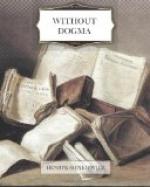His student days were spent at Warsaw. He devoted himself afterward to literature, writing at first under a pseudonym. He does not seem to have won immediate recognition. He spent some years in California; a series of articles published in this connection in a Polish paper brought him into notice.
In 1880, various novelettes and sketches of his production were published in three volumes.
In 1884 were given to the Polish public the three historical novels which immediately gave their author the foremost place in Polish literature. It is a matter of pride that the first translation of these great works into English is the work of an American, and offered to the American public.
He is a prolific writer, and it would be impossible to attempt to give even the names of all his minor sketches and romances. Some of them have been translated into German, but much has been lost in the translation.
Sienkiewicz is still a contributor to journalistic literature. He has travelled much, and is a citizen of the world. He is equally at home in the Orient or the West, by the banks of the Dnieper, or beside the Nile. Probably there is scarcely a corner of Poland that he has not explored. He depicts no type of life that has not actually come under his own observation. The various social strata of his own country, the condition of its peasantry, the marked contrast between the simplicity of that life and the culture of the ecclesiastic and aristocratic bodies, the religious, poetic, artistic temperament of the people,—all these he paints in a life-like fashion, but always as an artist.
So much of the writer. Of the man Sienkiewicz there is little to be obtained. Like all great creative geniuses, he is so completely identified with his work that even while his personality lives in his creations it eludes them. He offers us no confidences concerning himself, no opinions or prejudices. He does not divert the reader with personalities. He sets before us certain groups of men and women, whom certainly he knows and loves, and has lived among. He sets them in motion; they become living, breathing creations; they assume relations in time and space; they speak and act for themselves. If there be a prompter he remains always behind the scenes. Admire or criticise or love the actors as you will, you cannot for a moment doubt that they are alive.
This is the supreme miracle of genius,—the fine union of dramatic instinct, the aesthetic sense, and an intense, vital realism; not the realism of the cesspool or the morgue, but the realism of the earth and sky, and of healthy human nature. We are inclined to believe that Henryk Sienkiewicz has answered an often discussed question that has much exercised the keenly critical intellect of this age. One school of thought cries out, “Let us have life as it is. Paint anything, but draw it as it is. Let the final test of all literary works be, ’Is it real and true?’”




